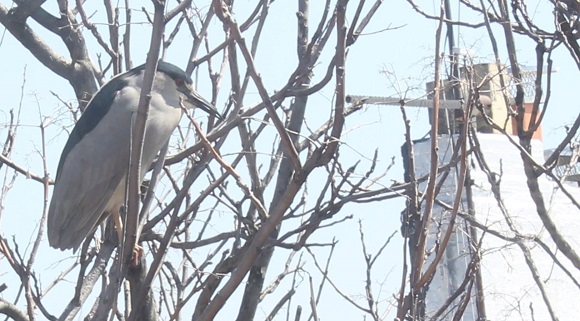A Mandarin Duck that appeared this winter in Central Park was separated from its natural habitat by a few oceans, but it was likely an escapee from a collection. Still, its attention-attracting plumage was in the news for weeks. Tourists and locals alike flocked to The Pond just to see its star attraction. But it wasn’t the first exotic species to grace NYC with its presence and certainly was not the last.
Shortly after the tragedy of September 11, 2001, not one, but two Calliope Hummingbirds arrived at Fort Tryon Park in Manhattan. They created a bit of a stir, as they are a western species, and were sought out not just by birders, but also by those trying to temporarily escape the gloomy mood permeating New York City at the time. The flashes of purple sparkling on their chins resembled fine jewels. An elderly German-American couple whose acquaintance I made told me they visited the park daily with the express purpose of checking on them. The birds stayed for about a month before winter took hold and they wisely decided to move on.
You may recall the 2018 Long-eared Owl sighting featured in the Juniper Berry’s March 2019 Berry Bits segment. These owls are nocturnal and dwell in dense forests. Why this bird was in a Middle Village yard during the day is anyone’s guess.
This past May, there were quite a few vagrant birds spotted in Queens. Two were away from their usual habitats by a few miles, while two others were off by quite a number of states.
One of the shorebird species found in NYC is the Great Egret. A male was spotted beginning in early April at Captain Tilly Park in the neighborhood of Jamaica Hill, which is completely landlocked. However, the park does feature a pond stocked with fish, which is the main attraction for the bird. The egret is regularly seen fishing and is quite successful at it. This is a very busy park, but the bird does not seem to be intimidated by humans, ignoring those who get close to it. As we go to press, the big white bird with long plumes remains in residence.
On May 6, a Black-crowned Night-Heron, a relatively common NYC bird that likewise lives along water bodies and hunts fish, was spotted in a tree in the backyard of a rowhouse on DeKalb Avenue in Ridgewood. It landed there sometime in the early morning hours and left just before sundown. Lael Marshall was lucky enough to capture the scene in a photo. A theory is that the bird was just resting after undertaking a long migration.
Ten days later on May 16, Jen Kepler, a biologist with the Wildlife Conservation Society, was tagging horseshoe crabs on a beach in Broad Channel when she spotted a Burrowing Owl in a marsh area undergoing reconstruction. These birds generally live and nest in holes created by prairie dogs. We don’t have those critters around, so why the owl was in a foreign habitat is a mystery. The other strange thing is the closest this species generally comes to New York is Florida. There is also a larger Burrowing Owl population out west. This individual was thought to be a western variety due to its pattern and the fact that the Florida birds generally don’t migrate.
The Burrowing Owl was looked for the following day, May 17, but not seen again. However, a short distance away at Jamaica Bay Wildlife Refuge, a Sage Thrasher was discovered. This species is native to areas with desert scrub, such as the southwestern US. The thrasher was sticking to grassy paths in the refuge. Two days later, it was gone.
Now these are just the birds of note that have been spotted. You may also recall back in 2015, a Coyote caused a panic as it ran around Middle Village. That one was captured and released elsewhere, but as coyotes are becoming more common in the urban environment, the City’s general policy is to leave them alone.
When you follow the natural world, there are always surprises in store. What rare animal will show up in our fair city next? Only time will tell. Unfortunately, how and why these mysterious rarities arrive is known only to them – and they aren’t telling.




